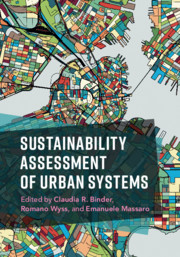Book contents
- Sustainability Assessment of Urban Systems
- Sustainability Assessment of Urban Systems
- Copyright page
- Contents
- Preface
- Acknowledgments
- Contributors
- General Introduction
- Part I Theoretical Background
- Part II Integrative Approaches for Sustainability Assessment
- 6 A Mixed-Method, Dialogue-Based Approach to Sustainability Assessments: Fostering Learning for Sustainable Development
- 7 Sustainability Assessment: Integrative Concept, Methodology, and Examples
- 8 Sustainability Solution Spaces
- 9 Assessing Urban Sustainability through Participatory Multi-Criteria Approaches (PMCAs): An Updated Comparative Analysis
- Part III Perspectives on Urban Sustainability
- Part IV Focal Points of Urban Sustainability
- Index
- References
9 - Assessing Urban Sustainability through Participatory Multi-Criteria Approaches (PMCAs): An Updated Comparative Analysis
from Part II - Integrative Approaches for Sustainability Assessment
Published online by Cambridge University Press: 27 March 2020
- Sustainability Assessment of Urban Systems
- Sustainability Assessment of Urban Systems
- Copyright page
- Contents
- Preface
- Acknowledgments
- Contributors
- General Introduction
- Part I Theoretical Background
- Part II Integrative Approaches for Sustainability Assessment
- 6 A Mixed-Method, Dialogue-Based Approach to Sustainability Assessments: Fostering Learning for Sustainable Development
- 7 Sustainability Assessment: Integrative Concept, Methodology, and Examples
- 8 Sustainability Solution Spaces
- 9 Assessing Urban Sustainability through Participatory Multi-Criteria Approaches (PMCAs): An Updated Comparative Analysis
- Part III Perspectives on Urban Sustainability
- Part IV Focal Points of Urban Sustainability
- Index
- References
Summary
This chapter presents a comparative analysis of four Participatory Multi-Criteria Approaches (PMCAs) usually applied in sustainability assessments (SMCE, MCM, 3-SPM, and INTEGRAAL). Such approaches are presented in detail and subsequently compared to each other according to three elementary yet crucial questions: who assesses?; what is assessed?; and how is it assessed? The results outline potential synergies and theoretical incompatibilities between the four approaches. The analysis also supports future PMCA applications when choosing one particular approach according to: key meta-principles (i.e., epistemological stance, methodological emphasis); logistical constraints (e.g., time, budget); local idiosyncrasies (e.g., pertinent geographical scales, power asymmetries); and organisational factors.
Keywords
- Type
- Chapter
- Information
- Sustainability Assessment of Urban Systems , pp. 209 - 238Publisher: Cambridge University PressPrint publication year: 2020



